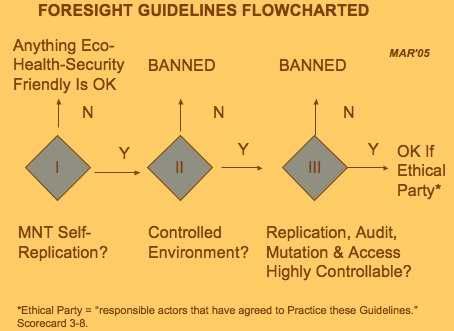page
2 of 6
Flowchart
of Controls
Figure 1 is a flowchart of the Foresight Institute guidelines that clearly
identifies what they address and what they neglect.

Figure 1
If we start with
Roman numeral block I, the first question to ask is whether or not MNT
is self-replicative. If the answer is no, then anything that is ecologically
healthy (especially in terms of healthy for the workers, but including public health as well) and that does not threaten national security is
okay. Therefore, anything that meets these three criteria is okay as long as
self-replication is not involved.
If
self-replication is indicated, the next question to address is seen
in diamond two, which is whether or not the self-replication occurs
in a controlled environment. If the answer is no, then the guidelines
are clear: It is banned. If the answer is yes, then you move on to decision
block three, which asks if there are replication audits, meaning that
we monitor where the nanobots have been, what they have done, and what
they know. Are all these things highly controllable even within the
controlled environment? If the answer is no, again, it is banned even
though it occurs inside a controlled environment.
If
these controls do not exist, then that technology is banned under the
Foresight Institute guidelines. If they do, it is okay as long as the
party that is operating that technology is an ethical party. The criteria
that defines whether a person is an ethical party is strict and that
party will probably be someone who had a perfect score on the scorecards
mentioned earlier.
Critique
Here is a quick critique of the Foresight Institute guidelines, based
on the flowchart. The guidelines seek specificity in terms of the exact
level of consequence, whether it's a  marketplace access consequence,
an economic penalty consequence, or a legal sanction. They seek a lot
of specificity based on the nature of the risk, yet the overall philosophy
is one that asks for minimal regulation. My experience, as an attorney
at least, is that these two goals can be antithetical. The more
you try to spell something out, the larger it gets. In fact the reason why the Code
of Federal Regulations is much longer than any of the law books is
because they try to explicate every different possibility in all of
the different areas of our economy and our lives. So when you try to
get specificity, you quickly lose minimality in your regulation.
marketplace access consequence,
an economic penalty consequence, or a legal sanction. They seek a lot
of specificity based on the nature of the risk, yet the overall philosophy
is one that asks for minimal regulation. My experience, as an attorney
at least, is that these two goals can be antithetical. The more
you try to spell something out, the larger it gets. In fact the reason why the Code
of Federal Regulations is much longer than any of the law books is
because they try to explicate every different possibility in all of
the different areas of our economy and our lives. So when you try to
get specificity, you quickly lose minimality in your regulation.
While
the Foresight Institute guidelines want minimal regulations, they actually
include strong anti-misuse penalties and even criminal sanctions. The
guidelines seem to take the position that self-replication is unnecessary,
uneconomic, and therefore unlikely. Yet they are overwhelmingly consumed
with the issue of self-replication to the point that nearly half of
the guidelines deal either explicitly or implicitly with self-replication.
So
one might worry that even though they say that self-replication is unnecessary
and unlikely, perhaps the authors of the guidelines are not very well
equipped to deal with the "black goo" scenario. Instead, our
fear of man-caused harm that we see every day overwhelmingly dominates
our thinking. For example, even though the news tells us about one Terry Schiavo
who dies or one person who gets shot in L.A., we obsess about that one person. It is horrible
that 52 people died in London. It is horrible that more than 3,000 died in
the World Trade Center. However, it is also a fact that 150,000 died
in the tsunami that followed in the wake of a volcanic
eruption in Southeast Asia and that 20,000 people die every single day of hunger. The question is, how do we deal with these situations?
1 2 3 4 5 6 next page>